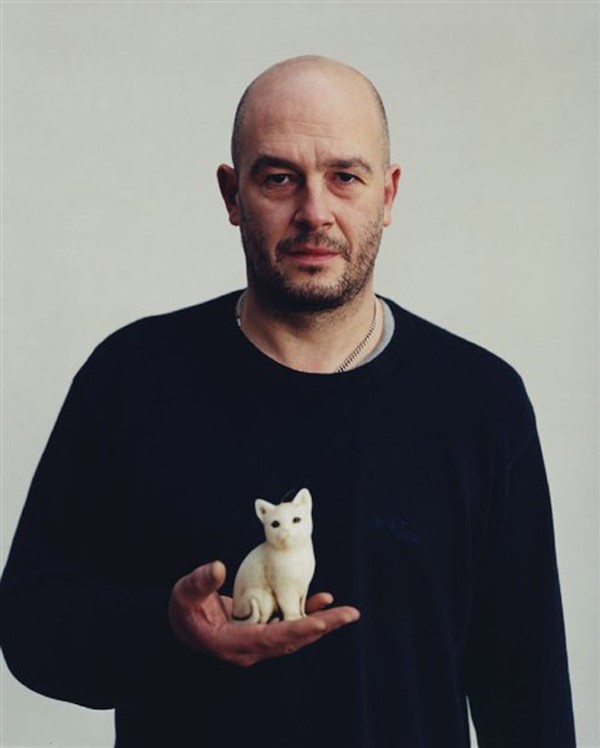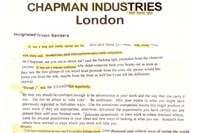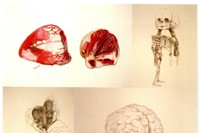Ahead of the upcoming Dazed 20th anniversary book, Making It Up As We Go Along, editor John-Paul Pryor talks to one-half of the Chapman brothers, Jake about the early Dazed days and his artwork being removed from WHSmith...
Next month, Rizzoli publish Making It Up As We Go Along – a must-have visual archive celebrating the 20-year visual history of Dazed & Confused magazine, edited by Jefferson Hack and Jo-Ann Furniss. Unsurprisingly, it’s a veritable smorgasbord of stimuli featuring iconic, game-changing work from some of the world’s greatest photographers, stylists and artists. John-Paul Pryor is one of the additional editors who worked on the forthcoming publication, sourcing interviews with some of the in-house movers and shakers that defined the early years of the magazine, and some of those contributors whose specially commissioned works helped to push the form forward in unique and boundary-defying ways. The Chapman Brothers came into the public sphere almost symbiotically with Dazed & Confused and the magazine became a regular compardre of the enfants terrible of the YBA movement, collaborating with the pair on fashion shoots where models toyed with entrails, producing poster pullouts of mututed children and creating self-mutilating fictional artists. On more than one occasion these interventions resulted in Dazed being removed from stockists, not that it ever curtailed the relationship between the brothers and the magazine. Here, Jake Chapman remembers re-sitting his GCSEs for a feature, the early days of the YBA movement and chucking pool balls through Rankin’s infinity curve.
Why do you think you had an affinity with Dazed?
I think Dazed had an appetite for notoriety and for doing stuff other magazines wouldn’t do. When we did the poster pullout it got taken off all the shelves in WHSmith. Dazed were very prepared to do stuff that would have negative feedback and they understood the point of that. It wasn’t simply used as a method for attention.
That rings true with your art also…
Well, people forget that the artists that were knocking about at the time were not aiming or intending to be successful, they were just doing what they were doing. I think because it was early days for everyone the parameters of maturity hadn’t been set, so it was just very, very funny and very chaotic really. The magazine was kind of doing the same thing in its own field. I can remember that every so often we would go back to the Dazed office – they had a pool table and an infinity curve and we used to try and chuck balls through it, it was just mayhem.
You undertook quite a few projects with Dazed & Confused over the years, including re-sitting your GCSEs… How did that come about?
I think it all began because someone from a newspaper phoned me at the studio and said, ‘How do you feel about being left out of the Turner Prize again?’ They had some kind of sense that I would feel rejected or overlooked – or whatever – not that I gave a toss. In an off-the-cuff, joking way I said, ‘Well, the reason we don’t get in is because we don’t have our Art O Levels.’ I said it was a requirement of the Turner Prize that you have to have O Level Art. They went off and made a few phone calls, and then they got me on Newsnight?! It was just a joke, but the Tate actually gave out a press release saying that it wasn’t a condition of the Turner Prize to have passed your O Level. Anyway, we just thought, ‘That’s fine, why don’t we just do our O Levels?’ It kind of came out of that. In everything we did with Dazed, they would say, ‘Do you want to do something?’ and we’d say, ‘Yeah, we want to do this...’ Then they’d say: ‘Okay.’ There was a kind of mutual consensus and irresponsibility that was symbiotic and fun. We went to a cramming college in Notting Hill and had to produce a year’s body of work in about two months, and then sit an eight-hour exam.
Scary! And one of your early sculptures was destroyed by the Dazed crew, wasn’t it?
Yeah, this sculpture called Mummy And Daddy Chapman. It was not a brilliant sculpture but someone from Dazed called up and asked if they could borrow it for a party and we said. ‘Yeah, of course.’ They came and they picked it up from my flat. They were mannequins called mummy and daddy with various forms of genitalia hanging off them. Anyway, Dazed had this party and the next morning they turned up and people at the party had broken off all the knobs. So, the next thing of course was to offer a ‘knob amnesty’ in the magazine the next month, saying ‘Have you got one of these knobs? Please could you post it back.’ I think only a couple were ever returned.
Were there other artists in the YBA movement whose work you liked, or did you consider yourselves to be outsiders doing your own thing?
I think that there were people that we liked. I mean, I like Damien’s work. I thought his work was more pessimistic and cynical than anyone else’s at the time, and that’s why I thought it was good. His work maintained an absolute refutation of any kind of human emotion and it was kind of like the inhuman world within the human – there was always a blank space where the human was. I think there were a lot of really bad artists at the time though. I actually despised most of them. I’m sure that was mutual. It seemed like a lot of people were going through the motions of almost self-indulgent, autobiographical art – people like Sarah Lucas and Tracy Emin – and that it was all about their egos and their personalities in a skanky, punk way, which was actually a contradiction, because punk was never about autobiography – it was never about the individual, it never had the patina of sentimentality.
Do you think the kind of punk attitude you are talking about is missing in art today?
Well, I don’t know what the causes are but I do think there should be some sort of emergent resistance, and I don’t understand why that isn’t happening. Maybe it is happening, but when I talk to younger artists that ask me, ‘How come you lot could do this and we can’t?’ I say, ‘Well, if you think about what we were faced with – the fact you could only be an artist when you 50 – then there was no model for young art.’ It was a lack of opportunity that we had to turn into an opportunity. Part of the situation we were stuck with was to treat marginality as a power rather than a lack of power. I don’t know whether this computes to a global society these days, and I don’t know if it’s because young artists are not getting their shit together or if they are just too obsessed by being successful, which actually becomes a self-evil.
I imagine lots of art students these days believe art is a sure-fire route to celebrity…
Maybe, but it’s self-hindering because, ultimately, the only way you’re going to be successful is if you’re any good. The problem is that if your preoccupation is trying to achieve success it eclipses the hard and fast task of doing something very interesting. That may be the problem. I don’t know. That sounds like an old bloke talking I think, and that’s my slightly distorted view, but it’s true that if you’re already preoccupied with the reception of the work and how to construct its reception, it just doesn’t work.



